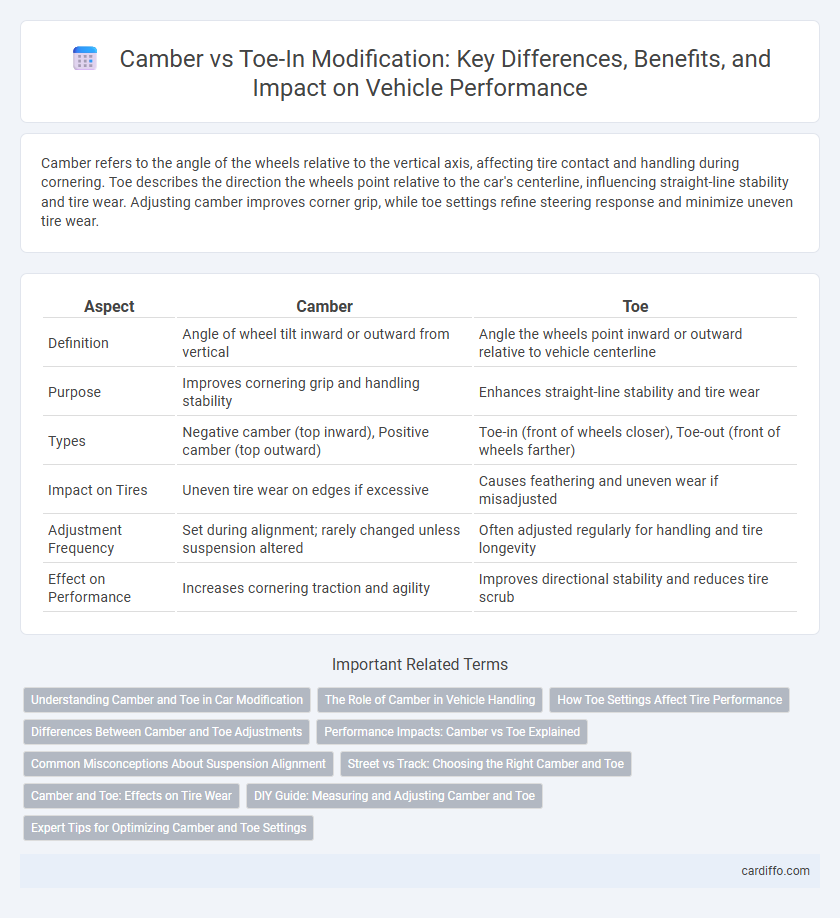Camber refers to the angle of the wheels relative to the vertical axis, affecting tire contact and handling during cornering. Toe describes the direction the wheels point relative to the car's centerline, influencing straight-line stability and tire wear. Adjusting camber improves corner grip, while toe settings refine steering response and minimize uneven tire wear.
Table of Comparison
| Aspect | Camber | Toe |
|---|---|---|
| Definition | Angle of wheel tilt inward or outward from vertical | Angle the wheels point inward or outward relative to vehicle centerline |
| Purpose | Improves cornering grip and handling stability | Enhances straight-line stability and tire wear |
| Types | Negative camber (top inward), Positive camber (top outward) | Toe-in (front of wheels closer), Toe-out (front of wheels farther) |
| Impact on Tires | Uneven tire wear on edges if excessive | Causes feathering and uneven wear if misadjusted |
| Adjustment Frequency | Set during alignment; rarely changed unless suspension altered | Often adjusted regularly for handling and tire longevity |
| Effect on Performance | Increases cornering traction and agility | Improves directional stability and reduces tire scrub |
Understanding Camber and Toe in Car Modification
Camber and toe are critical alignment settings that influence tire contact and vehicle handling in car modification. Camber refers to the angle of the wheels relative to the vertical axis, affecting cornering grip and tire wear, while toe describes the direction the wheels point relative to the car's centerline, impacting steering response and stability. Proper adjustment of camber and toe enhances performance by balancing tire traction, handling precision, and tire longevity.
The Role of Camber in Vehicle Handling
Camber significantly influences vehicle handling by affecting tire contact with the road during cornering; negative camber improves grip by maximizing the tire's contact patch in turns. Properly adjusted camber enhances cornering stability and reduces understeer, while excessive negative camber can cause uneven tire wear and compromised straight-line traction. Compared to toe adjustments, camber plays a more critical role in lateral grip and vehicle responsiveness during high-speed maneuvers.
How Toe Settings Affect Tire Performance
Toe settings significantly influence tire performance by altering the contact patch and tire wear patterns during driving. Toe-in enhances straight-line stability but can increase tire scrub, leading to faster wear on outer edges. Conversely, toe-out improves cornering responsiveness by allowing the tires to turn slightly outward, yet it may cause uneven tire wear and reduce overall tire lifespan.
Differences Between Camber and Toe Adjustments
Camber adjustments change the vertical tilt of the wheels relative to the road, affecting tire contact patch and cornering grip. Toe adjustments modify the direction the wheels point inward or outward, influencing straight-line stability and tire wear. Understanding these differences is crucial for optimizing vehicle handling and performance during suspension tuning.
Performance Impacts: Camber vs Toe Explained
Camber adjustment directly affects tire contact patch and cornering grip, improving handling stability during high-speed turns. Toe settings influence straight-line stability, tire wear, and responsiveness by altering the alignment angle of the wheels relative to the vehicle's centerline. Optimizing camber enhances lateral grip, while fine-tuning toe balances steering precision and tire longevity for overall improved performance.
Common Misconceptions About Suspension Alignment
Camber and toe are critical suspension alignment parameters often misunderstood in vehicle dynamics. Camber refers to the vertical tilt of the wheels, influencing tire contact and cornering stability, while toe describes the horizontal angle affecting steering response and tire wear. Misconceptions include treating camber and toe adjustments as interchangeable fixes, whereas each serves distinct roles in optimizing handling performance and tire longevity.
Street vs Track: Choosing the Right Camber and Toe
Street vehicles typically benefit from mild camber settings around -0.5 to -1.0 degrees for balanced tire wear and comfortable handling, while toe angles are kept near zero or slight toe-in for stability. Track cars often use more aggressive negative camber, ranging from -2.0 to -3.5 degrees, to maximize cornering grip, paired with slight toe-out at the front for sharper turn-in response. Proper camber and toe alignment tailored to driving conditions optimize tire performance, grip, and vehicle dynamics for either street comfort or track precision.
Camber and Toe: Effects on Tire Wear
Camber affects the tire's contact patch by tilting the wheels inward or outward, which can cause uneven tire wear predominantly on the inner or outer edges. Toe alignment adjusts the direction the tires point relative to the vehicle's centerline, impacting tire wear by causing scrubbing when the wheels are angled inward (toe-in) or outward (toe-out). Precise camber and toe settings are crucial for optimizing tire longevity, performance, and handling characteristics.
DIY Guide: Measuring and Adjusting Camber and Toe
Measuring camber involves using a camber gauge or smartphone app to determine the angle between the wheel and vertical axis, while toe measurement requires a toe gauge or tape measure to assess the distance between front and rear of tires. Adjusting camber typically entails loosening control arm bolts and pivoting the wheel assembly, whereas toe adjustments are made by turning tie rod ends to align the wheels parallel or slightly divergent. Accurate DIY modification of camber and toe improves tire wear, handling, and overall vehicle stability.
Expert Tips for Optimizing Camber and Toe Settings
Expert tips for optimizing camber and toe settings emphasize balancing tire contact patch for improved grip and tire wear. Negative camber enhances cornering stability by increasing lateral traction, while proper toe alignment ensures straight-line stability and reduces uneven tire wear. Precise adjustments based on track conditions and driving style maximize performance and safety.
camber vs toe Infographic

 cardiffo.com
cardiffo.com